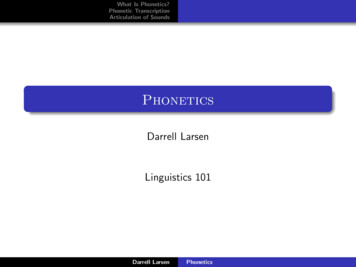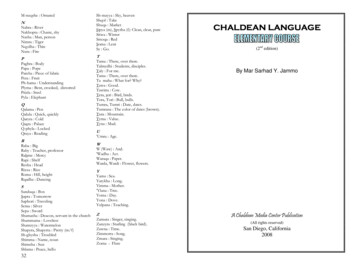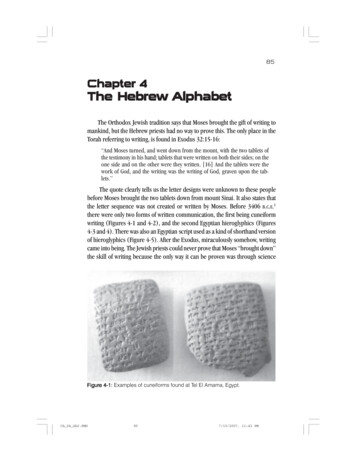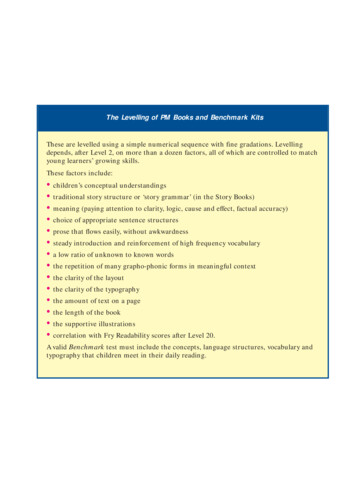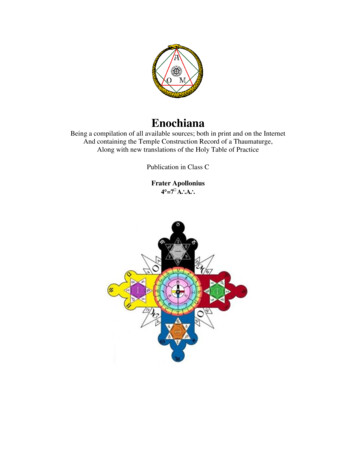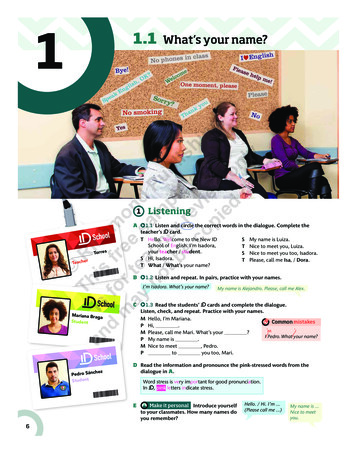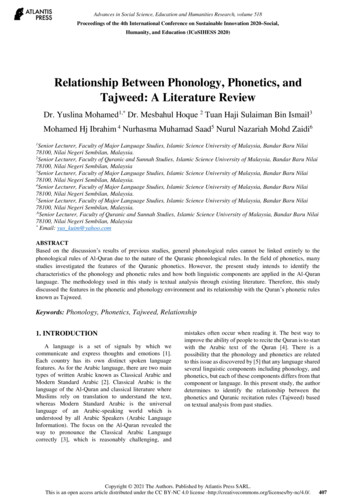
Transcription
THE INTERNATIONALPHONETIC ALPHABET (revised to 1989)CONSONANTSA Course In PhoneticsThird EditionPeter LadefogedCUniversity of California, ohgelessWheresymbols appear in pain, the one to the right represents a voicedconranant. Shaded areas denote anicularions judged -mide@EY o 0(RA3OpenWhere symbols appear in pain the one to the rightrepresents a rounded vowel.Harcourt Brace Jovanovich College PublishersConttnued on Ins{& back coverFort Worth Philadelphia San Diego New York Orlando Austin San AntonioToronto Montreal London Sydney Tokyo
ArticulatoryPhoneticsPhonetics is concerned with describing the speech sounds that occur inthe languages of the world. We want to know what these sounds are,how they fall into patterns, and how they change in different circumstances. Most importantly, we want to know what aspects of the sounds arenecessary for conveying the meaning of what is being said. The first job ofa phonetician is, therefore, to try to find out what people are doing whenthey are talking and when they are listening to speech.We will begin by describing how speech sounds are made. In nearly allspeech sounds, the basic source of power is the respiratory system pushingair out of the lungs. Try to talk while breathing in instead of out. You willfind that you can do it, but it is much more inefficient than superimposingspeech on an outgoing breath.Air from the lungs goes up the windpipe (the trachea, to use the more,technical term) and into the larynx, at which point it must pass betweentwo small muscular folds called the vocal cords. If the vocal cords areapart, as they normally are when breathing out, the air from the lungs willhave a relatively free passage into the pharynx and the mouth. But if thevocal cords are adjusted so that there is only a narrow passage between
2T h e Vocal OrgansArticulatory PhoneticsSue, zoo" the first consonant in the first word of each pair is voiceless,whereas in the second word, it is voiced. To check this for yourself, sayjust the consonant at the beginning of each of these words and try to feeland hear the voicing as suggested above. Try to find other pairs of wordsthat are distinguished by one having a voiced and the other having a voice0less consonant.The air passages above the larynx are known as the vocal tract. Figure1.1 shows their location within the head (actually within my head). Theshape of the vocal tract is a very important factor in the production ofspeech, and we will often refer to a diagram of the kind that has beensuperimposed on the photograph in Figure 1.1. Learn to draw the vocaltract by tracing the diagram in this figure. Note that the air passages thatmake up the vocal tract may be divided into the oral tract within the mouthand pharynx, and the nasal tract within the nose. The upper limit of thenasal tract has been marked with a dotted line since the exact boundaries ofthe air passages within the nose depend on soft tissues of variable size.The parts of the vocal tract that can be used to f o m sounds are calledarticulators. The articulators that form the lower surface of the vocal tractoften move toward those that form the upper surface. Try saying the word"capital" and note the major movements of your tongue and lips. You willfind that the back of the tongue makes contact with the roof of the mouthfor the first sound and then comes down for the following vowel. The lipscome together in the formation of p and then come apart again in thevowel. The tongue tip comes up for the t and again, for some people, forthe final 1.The names for the principal parts of the upper surface of the vocal tractare given in Figure 1.2. The upper lip and the upper teeth (notably thefrontal incisors) are familiar enough structures. Just behind the upper teethis a small protubeiance that you can feel with the tip of the tongue. This isFigure 1.1The vocal tract.them, the airstream will cause them to vibrate. Sounds produced when thevocal cords are vibrating are said to be voiced, as opposed to those inwhich the vocal cords are apart, which are said to be voiceless.In order to hear the difference between a voiced and a voiceless sound,try saying a long v sound, which we will symbolize as [vvvvv]. Now compare this with a long f sound [fffffl, saying each of them alternately[ffffvvvvvfffffvvvvv]. Both of these sounds are formed in the same way inthe mouth. The difference between them is that [v] is voiced but [fl isvoiceless. You can feel the vocal cord vibrations in [v] if you put your fingertips against your larynx. You can also hear the buzzing of the vibrationsin [v] more easily if you stop up your ears while contrasting [fffffvwvv].The difference between voiced and voiceless sounds is often importantin distinguishing sounds. In each of the pairs of words "fat, vat; thigh, thy;Figure 1.2The principal parts of the upper surface of the vocal tract.3
i4Articulatory PhoneticsPlaces o f Articulationcalled the alveolar ridge. You can also feel that the front part of the roofof the mouth is formed by a bony structure. This is the hard palate. Youwill probably have to use a fingertip to feel further back. Most people cannot curl the tongue up far enough to touch the' soft palate, or velum, at theback of the mouth. The soft palate is a muscular flap that can be raised topress against the back wall of the pharynx and shut off the nasal tract, preventing air from going out through the nose. In this case there is said to bevelic closure. This action separates the nasal tract from the oral tract sothat the Bir can go out only through the mouth. At the lower end of the softpalate is a small appendage hanging down that is known as the uvula. Thepart of the vocal tract between the uvula and the larynx is the pharynx. Theback wall of the pharynx may be considered to be one of the articulatorson the upper surface of the vocal tract. Figure 1.3 shows the lower lip andthe specific names for different parts of the tongue that form the lower surface of the vocal tract:hard palate or on the velum? (For most people, it is centered between thetwo.) Then note the position in the formation of the I. Most people makethis sound with the tip of the tongue on the alveolar ridge.Now compare the words "true" and "tea." In which word is the tonguecontact further forward in the mouth? Most people make contact with thetip or blade of the tongue on the alveolar ridge when saying "tea," butslightly farther back in "true." Try to distinguish the differences in otherconsonant sounds, such as those in "sigh" and "shy" and those in "fee" and"the."0When considering diagrams such as those discussed thus far, it isimportant to remember that they show only two dimensions. The vocaltract is a tube, and the positions of the sides of the tongue may be very different from that of the center. In saying "sigh," for example, there is a deephollow in the center of the tongue that is not present when saying "shy ." Itis difficult to represent this difference in a two-dimensional diagram showing just the mid-line of the tongue-a so-called mid-sagittal view. We willbe relying on mid-sagittal diagrams of the vocal organs to a considerableextent in this book. But we should never let this simplified view becomethe sole basis for our conceptualization of speech sounds.IIIIIIIFigure 1.3 The principal parts of the lower surface of the vocal tract.IIIIThe tip and blade of the tongue are the most mobile parts. Behind theblade is what is technically called the front of the tongue: it is actually theforward part of the body of the tongue, and lies underneath the hard palatewhen the tongue is at rest. The remainder of the body of the tongue may bedivided into the center, which is partly beneath the hard palate and partlybeneath the soft palate, the back, which is beneath the soft palate, and theroot, which is opposite the back wall of the pharynx. The epiglottis isattached to the lower part of the root of the tongue.Bearing all these terms in mind, say the word "peculiar" and try to givea rough description of the actions of the vocal organs during the consonantsounds. You should find that the lips come together for the first sound.Then the back and center of the tongue are raised. But is the contact on theIIIIIIIIn order to form consonants, the airstream through the vocal tract mustbe obstructed in some way. Consonants can therefore be classified according to the place and manner of this obstruction. The primary articulatorsthat can cause an obstruction in most languages are the lips, the tongue tipand blade, and the back of the tongue. Speech gestures using the lips arecalled labial articulations; those using the tip or blade of the tongue arecalled coronal articulations; and those using the back of the tongue arecalled dorsal articulations.If we do not need to specify the place of articulation in great detail,then the articulators for the consonants of English (and of many other languages) can be described using these terms. The word "topic," for example, begins with a coronal consonant; in the middle there is a labial consonant; and at the end a dorsal consonant. (Check this by feeling that the tipor blade of your tongue is raised for the first, coronal, consonant, your lipsclose for the second, labial, consonant, and the back of the tongue is raisedfor the final, dorsal, consonant.)These terms, however, do not specify articulatory gestures in sufficientdetail for many phonetic purposes. More specific places of articulation areindicated by the arrows going from one of the lower articulators to one ofthe upper articulators in Figure 1.4. The principal terms for these particulartypes of obstruction, all of which are required in the description of English,follow.5
6Articulatory PhoneticsFigure 1.4 Places of articulation: 1 Bilabial; 2 Labiodental; 3 ental,;4 Alveolar; 5 Retroflex; 6 Palato-Alveolar; 7 Palatal; 8 Velar.1. Bilabial(Made with the two lips.) Say words such as "pie, buy, my" and notehow the lips come together for the first sound in each of these words.Find a comparable set of words with bilabial sounds at the end.2. Labiodental(Lower lip and upper front teeth.) Most people, when saying wordssuch as "fie, vie," raise the lower lip until it nearly touches the upperfront teeth.3. Dental(Tongue tip or blade and upper front teeth.) Say the words "thigh, thy."Some people (most speakers of American English) have the tip of thetongue protruding between the upper and lower front teeth; others(most speakers of British English) have it close behind the upper frontteeth. Both these kinds of sounds are normal in English, and both maybe called dental. If a distinction is needed, sounds in which the tongueprotrudes between the teeth may be called interdental.4. Alveolar(Tongue tip or blade and the alveolar ridge.) Again there are two possibilities in English, and you should find out which you use. You maypronounce words such as "tie, die, nigh, sigh, zeal, lie" using the tip ofPlaces of Articulationthe tongue or the blade of the tongue. Feel how you normally make thealveolar consonants in each of these words, and then try to make themin the other way. A good way to appreciate the difference betweendental and alveolar sounds is to say "ten" and "tenth" (or "n" and"nth"). Which n is farther back? (Most people make the one in the firstof each of these pairs of words on the alveolar ridge and the second asa dental sound with the tongue touching the upper front teeth.)5. Retroflex(Tongue tip and the back of the alveolar ridge.) Many speakers ofEnglish do not use retroflex sounds at all. But for some, retroflexsounds occur initially in words such as "rye, row, ray." Note the position of the tip of your tongue in these words. Speakers who pronouncer at the ends of words may also have retroflex sounds with the tip ofthe tongue raised in "ire, hour, air."6. Palato-Alveolar(Tongue blade and the back of the alveolar ridge.) Say words such as"shy, she, show." During the consonants, the tip of your tongue may bedown behind the lower front teeth, or it may be up near the alveolarridge, but the blade of the tongue is always close to the back part of thealveolar ridge. Try saying "shipshape" with your tongue tip up on oneoccasion and down on another. Note that the blade of the tongue willalways be raised. You may be able to feel the place of articulationmore distinctly if you hold the position while taking in a breaththrough the mouth. The incoming air cools the blade of the tongue andthe back part of the alveolar ridge.7. Palatal(Front of the tongue and hard palate.) Say the word "you" very slowlyso that you can isolate the consonant at the beginning. If you say thisconsonant by itself, you should be able to feel that the front of thetongue is raised toward the hard palate. Try to hold the consonant position and breathe inward through the mouth. You will probably be ableto feel the rush of cold air between the front of the tongue and the hardpalate.8. Velar(Back of the tongue and soft palate.) The consonants that have the farthest back place of articulation in English are those that occur at theend of "hack, hag, hang." In all these sounds, the back of the tongue israised so that it touches the velum.As you can tell from the descriptions of these articulations, the firsttwo, bilabial and labiodental, can be classified as labial, involving at leastthe lower lip; the next four, dental, alveolar, retroflex and palato-alveolar,are coronal articulations, with the tip or blade of the tongue raised; and thelast, velar, is a dorsal articulation, using the back of the tongue. Palatalsounds are sometimes classified as coronal articulations, and sometimes asdorsal articulations, a point to which we shall return.7
Manners of ArticulationArticulatory PhoneticsTo get the feeling of different places of articulation, consider the consonant at the beginning of each of the following words: "fee, theme, see,she." Say these consonants by themselves. Are they voiced or voiceless?Now note that the place of articulation moves back in the mouth in makingthis series of voiceless consonants, going from labiodental, through dentaland alveolar, to palato-alveolar.Consider the consonants at the ends of "rang, ran, ram." When you saythese consonants by themselves, note that the air is coming out through thenose. In the formation of these sounds, the point of articulatory closuremoves forward, from velar in "rang," through alveolar in "ran," to bilabialin "ram." In each case, the air is prevented from going out through themouth, but is able to go out through the nose because the soft palate, orvelum, is lowered.In most speech, the soft palate is raised so that there is a velic closure.When it is lowered and there is an obstruction in the mouth, we say thatthere is a nasal consonant. Raising or lowering the velum controls the oronasal process, the distinguishing factor between oral and nasal sounds.At most places of articulation there are several basic ways in whicharticulation can be accomplished. The articulators may close off the oraltract for an instant or a relatively long period; they may narrow the spaceconsiderably; or they may simply modify the shape of the tract byapproaching each other.Figure 1.5 The positions of the vocal organs in the bilabial stopin "buy.";(velar closure). Figure 1.6 shows the position of the vocal organs duringthe bilabial nasal stop in "my." Apart from the presence of a velic closure,there is no difference between this stop and the one in "buyn-shown inFigure 1.5. Although both the nasal sounds and the oral sounds can be classified as stops, the term stop by itself is almost always used by phoneticians to indicate an oral stop, and the term nasal to indicate a nasal stop.Thus the consonants at the ends of the words "bad" and "ban" would becalled an alveolar stop and an alveolar nasal respectively. Although theterm stop may be defined so that it applies only to the prevention of airescaping through the mouth, it is commonly used to imply a complete stoppage of the airflow through both the nose and the mouth.Stop(Complete closure of the articulators involved so that the airstreamcannot escape through the mouth.) There are two possible types of stop.Oral stop If in addition to the articulatory closure in the mouth, thesoft palate is raised so that the nasal tract is blocked off, then the airstreamwill be completely obstructed. Pressure in the mouth will build up and anoral stop will be formed. When the articulators come apart, the airstreamwill be released in a small burst of sound. This kind of sound occurs in theconsonants in the words "pie, buy" (bilabial closure), "tie, dye" (alveolarclosure), and "kye, guy" (velar closure). Figure 1.5 shows the positions ofthe vocalorgans in the bilabial stop in "buy."Nasal stop If the air is stopped in the oral cavity but the soft palate isdown so that it can go out through the nose, the sound produced is a nasalstop. Sounds of this kind occur at the beginning of the words "my" (bilabial closure) and "nigh" (alveolar closure) and at the end of the word "sang"Figure 1.6 The position of the vocal organs during the bilabial nasalstop in "my."
110Manners of ArticulationMculatory Phoneticshow, despite the closure formed by the tongue, air flows out freely, overthe side of the tongue. Because there is no stoppage of the air, and not evenany fricative noises, these sounds are classified as approximants. The consonants in words such as "lie, laugh" are alveolar lateral approximants, butthey are usually called just alveolar laterals, their approximant status beingassumed. You may be able to find out which bide.of the tongue is not incontact with the roof of the mouth by holding the consonant-position whileyou breathe inward. The tongue will feel colder on the side that is not incontact with the roof of the mouth.Additional Consonantal ArticulationsFigure 1.7 The positions of the vocal organs in the palato-alveolarfricative in "shy."Fricative(Close approximation of two articulators so that the airstream is partially obstructed and turbulent airflow is produced.) The mechanisminvolved in making these slightly hissing sounds may be likened to thatinvolved when the wind whistles around a comer. The consonants in "fie,vie" (labiodental), "thigh, thy" (dental), "sigh, zoo" (alveolar), and "shy"(palato-alveolar) are examples of fricative sounds. Figure 1.7 illustratesone pronunciation of the palato-alveolaf fricative consonant in "shy." Notethe narrowing of the vocal tract between the blade of the tongue and theback part of the alveolar ridge. The higher-pitched sounds with a moreobvious hiss, such as those in "sigh, shy," are sometimes called sibilants.Approximant(An articulation in which one articulator is close to another, but without the vocal tract being narrowed to such an extent that a turbulentairstream is produced.) In saying the first sound in "yacht" the front. ofthetongue is raised toward the palatal area of the roof of the mouth, but it doesnot come close enough for a fricative sound to be produced. The consonants in the word "we" (approximation between the lips and in the velarregion) and, for some people, in the word "raw" (approximation in thealveolar region) are also examples of approximants.Lateral (Approximant)(Obstruction of the airstream at a point along the center of the oraltract, with incomplete closure between one or both sides of the tongue andthe roof of the mouth.) Say the word "lie" and note how. the tongue touchesnear the center of the alveolar ridge. Prolong the initial consonant and noteIn this preliminary chapter, it will not be necessary to discuss all of the':manners of articulation used in the various languages of the world-nor,for that matter, in English. But it might be useful to know the terms trill(sometimes called roll), and tap (sometimes called flap). Tongue-tip trillsoccur in some forms of Scottish English in words such as "rye" and "raw."Taps, in which the tongue makes a single tap against the alveolar ridge,occur in the middle of a word such as "letter" in many forms of AmericanEnglish.The production of some sounds .involves more than one of these manners of articulation. Say the word ''cheapV and think about how you makethe first sound. At the beginning, the tongue comes up to make contactwith the back part of the alveolar ridge to form a stop closure. This contactis then slackened so that there is a fricative at the same place of articulation. This kind of combination of a stop immediately followed by a fricative is called an affricate, in this case a palato-alveolar affricate. There is avoiceless affricate at the beginning and end of the word "church." The corresponding voiced affricate occurs at the beginning and end of "judge." Inall these sounds the articulators (tongue tip or blade and alveolar ridge)come together for the stop; and then, instead of coming fully apart, theyseparate only slightly, so that a fricative is made at the same place of articulation. Try to feel these movements in your own pronunciation of thesewords.To summarize, the consonants we have been discussing so far may bedescribed in terms of five factors: (1) state of the vocal cords (voiced orvoiceless); (2) place of articulation; (3) central or lateral articulation; (4)soft palate raised to form a velic closure (oral sounds) or lowered (nasalsounds); (5) manner of articulatory action. Thus the consonant at thebeginning of the word "sing" is a (1)voiceless, (2) alveolar, (3) central, (4)foral, (5) fricative; and the consonant at the end of "sing" is a (1) voiced,(2) velar, (3) central, (4) nasal, (5) stop.On most occasions it is not necessary to state all these five points.Unless a specific statement to the contrary is made, consonants are usuallypresumed to be central, not lateral, and oral rather than nasal. Consequently, points (3) and (4) may often be left out, so that the consonant at1I
12The Articulation of Vowel SoundsArticulatory Phoneticsthe beginning of "sing" is simply called a voiceless alveolar fricative.When describing nasals, point (4) has to be specifically mentioned andpoint (5) can be left out, so that the consonant at the end of "sing" is simply called a voiced velar nasal.In the production of vowel sounds, the articulators do not come very closetogether, and the passage of the airstream is relatively unobstructed. Vowelsounds may be specified in terms of the position of the highest point of thetongue and the position of the lips. Figure 1.8 shows the articulatory position for the vowels in "heed, hid, head, had, father, good, food." As youcan see, in all these vowels the tongue tip is down behind the lower frontteeth, and the body of the tongue is domed upward. Check that this is so inyour own pronunciation. In the first fodr vowels, the highest point of thetongue is in the front of the mouth. Accordingly, these vowels are calledfront vowels. The tongue is fairly close to the roof of the mouth for thevowel in "heed," slightly less close for the vowel in "hid," and lower stillfor the vowels in "head" and "had." If you look in a mirror while sayingthe vowels in these four words, you will find that the mouth becomes progressively more open while the tongue remains in the front of the mouth.The vowel in'"heed" is classified as a high front vowel, and the vowel in"had" as a low front vowel. The height of the tongue for the vowels in theother words is between these two extremes, and they are therefore calledmid-front vowels. The vowel in "hid" is a mid-high vowel, and the vowelin "head" is a mid-low vowel.Now try saying the vowels in "father, good, food." Figure 1.8 alsoshows the articulatory position for these vowels, In all three, the tongue isclose to the upper or back surface of the vocal tract. These vowels are classified as back vowels. The body of the tongue is highest in the vowel in"food" (which is therefore called a high back vowel), and lowest in the firstvowel in "father" (which is therefore called a low back vowel).'The vowelin "good" is a mid-high back vowel.The position of the lips varies considerably in different vowels. Theyare generally closer together in the mid and high back vowels (as in "good,food"), though in some forms of American English this is not so. Look atthe position of your lips in a mirror while you say just the vowels in"'heed, hid, head, had, father, good, food." You will probably find that inthe last two words there is a movement of the lips in addition to the movement that occurs because of the lowering and raising of the jaw. Thismovement is called lip rounding. It is usually most noticeable in the forward movement of the comers of the lips. Vowels may be described asbeing rounded (as in "who'd") or unrounded (as in "heed").In summary, vowels can be described in terms of three factors: (1) theheight of the body of the tongue; (2) the front-back position of the tongue;and (3) the degree of lip rounding. The relative positions of the highestpoints of the tongue are given in Figure 1.9. Say just the vowels in thewords given below this figure and check that your tongue moves in the pattern described by the points. It is very difficult to become aware of theposition of the tongue in vowels, but you can probably get some impressionfronthighbackI midFigure 1.8 The positions of the vocal organsfor the vowels in thewords I heed, 2 hid, 3 head, 4 had, 5 father, 6 good, 7food. The lippositions for vowels 2,3, and 4 are in between those shownfor I and 5.The lip position for vowel 6 is between those shown for I and 7.lowFigure 1.9 The relativepositions of the highestpoinrs of the tongue inthe vowels in I heed, 2 hid, 3 head, 4 had, 5 father, 6 good, 7food.13:
14Articulatory Phoneticsof tongue height by observing the position of your jaw while saying'just thevowels in the four words, "heed, hid, head, had." You should also be ableto feel the difference between front and back vowels by contrasting wordssuch as "he" and "who." Say these words silently and concentrate on thesensations involved. You should feel the tongue going from front to backas you say "he, who." You can also feel your lips becoming more rounded.As you can see from Figure 1.9, the specification of vowels in terms ofthe position of the highest point of the tongue is not entirely satisfactoryfor a number of reasons. First, the vowels that are called high do not havethe same tongue height. The back high vowel (point 7) is nowhere near ashigh as the front vowel (point 1). Second, the so-called back vowels varyconsiderably in their degree of backness. Third, as you can see by lookingat Figure 1.8, this kind of specification disregards considerable differencesin the shape of the tongue in front vowels and in back vowels. Furthermore,it does not take into account the fact that the width of the pharynx variesconsiderably with, and to some extent independently of, the height of thetongue in different vowels. We will discuss better ways of describing vowels in Chapters 4 and 9.Vowels and consonants can be thought of as the segments of whichspeech is composed. Together they form the syllables, which go to make uputterances. Superimposed on the syllables there are other features known assuprasegmentals. These include variations in stress and pitch. Variations inlength are also usually considered to be suprasegmental features, althoughthey can affect single segments as well as whole syllables.Variations. in stress are used in English to distinguish between a nounand a verb, as in "(an) insult" versus "(to) insult." Say these words yourself, and check which syllable has the greater stress. Then compare similarpairs, such as "(a) pervert, (to) pervert" or "(an) overflow, (to) overflow."You should find that in the nouns the stress is on the first syllable, but inthe verbs it is on the last. Thus, stress can have a grammatical function inEnglish. It can also be used for contrastive emphasis (as in "I want a redpen, not a black one"). Variations in stress are caused by an increase in theactivity of the respiratory muscles (so that a greater amount of air is pushedout of the lungs) and in the activity of the laryngeal muscles (so that thereis a significant change in pitch).You can usually find where the stress occurs on a word by trying to tapwith your finger in time with each syllable. It is much easier to tap on thestressed syllable. Try saying "abominable" and tapping first on the firstsyllable, then on the second, then on the third, and so on. If you say theword in your normal way you will find it easiest to tap on the second syllable. Many people cannot tap on the first syllable without altering their normal pronunciation.Pitch changes due to variations in laryngeal activity can occur independently of stress changes. When they do, they can affect the meaning of thesentence as a whole. The pitch pattern in a sentence is known as the intonation. Listen to the intonation (the variations in the pitch of your voice)when you say the sentence "This is my father." Try to find out which syllable has the highest pitch and which the 1owest:In most people's speech thehighest pitch will occur on the first syllable of "father" and the lowest onthe second. Now observe the pitch changes in the question "Is this yourfather?" In this sentence the first syllable of "father" is usually on a lowpitch, and the last syllable is on a high pitch. In English it is even possibleto change the meaning of a sentence such as "That's a cat" from a statement to a question without altering the order of the words. If you substitutea mainly rising for a mainly falling intonation, you will produce a questionspoken with an air of astonishment: "That's a cat?"All the suprasegmental features are characterized by the fact that theymust be described in relation to other items in the same utterance. It is therelative values of pitch, length, or degree of stress of an item that are signi
The names for the principal parts of the upper surface of the vocal tract are given in Figure 1.2. The upper lip and the upper teeth (notably the frontal incisors) are familiar enough structures. Just behind the upper teeth is a small protubeiance that you can feel with the tip of the tongue. This is
